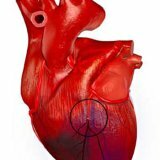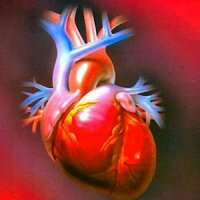Causes and stages of myocardial infarction

Myocardial infarction is the necrosis of a specific area of the heart muscle that occurs when blood flow is disturbed in the arteries. It refers to the acute form of coronary heart disease, characterized by a disruption in the supply of blood, nutrients and oxygen. The dead tissue site on the heart muscle is called the infarction zone. The disease most often develops in the left part, or in the region of the dividing heart partition.
Causes of myocardial infarction.
Factors that affect the occurrence of myocardial infarction include disturbance of blood flow in the coronary arteries, atherosclerosis, age, arterial hypertension, obesity, smoking and sedentary lifestyle.
With arteriosclerosis, arteries are formed areas on which a part of the wall breaks down, which causes narrowing( stenosis) or thrombosis of the coronary vessels. It is he who is the main cause of heart attack and refers to an independent nosological form. A pronounced atherosclerosis is detected in 95% of deaths from myocardial infarction. It affects most( 80% - 85% of cases) of the coronary arteries. In some cases, the cause of the disease is also the non-atherosclerotic lesion of the arteries, and, thus, it contributes to the development of other cardiovascular diseases.
Another reason for developing a heart attack is age, since the risk of atherosclerosis rises after fifty years. In addition, arterial hypertension accelerates its development and adversely affects the cardiac wall.
Smoking can be attributed to one of the most common causes of an infarction. This is due to the fact that the coronary vessels of the heart are narrowed and, at the same time, the supply of the heart muscle is reduced by blood.
Sedentary lifestyle is often the cause of obesity, namely, people with excessive weight are most often at risk of developing myocardial infarction. Obesity accelerates the development of atherosclerosis, as well as diabetes and hypertension. All this leads to an inferior blood supply to the heart and damage to its walls and walls of venous arteries. This shows that myocardial infarction is the most common disease among the elderly and overweight.
Stages of myocardial infarction.
Myocardial infarction develops in four stages.
The stage of damage is the first among the four. Usually it lasts for several hours, and it can go up to three days. During this period, there is transmural damage to the muscle fibers, which occurs due to acute circulatory disorders. As a rule, at this stage transmural or nontransmural necrosis is formed in the very center of the transmural lesion zone. All this can be detected using an electrocardiogram. If the result of the ECG shows that the abnormal tooth Q is absent, then necrosis has not yet formed. In the case of necrosis formation, the Q wave gradually forms, which becomes noticeable in the conclusion of the ECG.Most often, this prong appears within two days after the development of myocardial infarction. But it is possible that it can be formed in six days.
The pathological Q wave is divided into QR( where, R is a tooth similar to Q), Qr( non-transural infarction), and QS( transmural myocardial infarction).
Excess of ST segment contour of 4 mm in any of the twelve branches gives a serious prediction that the person will soon undergo a heart attack.
The next stage of myocardial infarction is the acute stage. It lasts for two to three weeks and may occur within a few hours after the disease. During this period, the damaged area is reduced due to necrosis or restoration of a part of the muscle fibers. When the damage is restored, it gradually becomes ischemia.
If you look at the ECG at this stage, you immediately see how the ST segment is reduced to the isoline, as the damage area is gradually decreasing. Also, in some patients, one can see a rise in the segment, which persists for more than three weeks. This often occurs with anterior infarction. With a posterior wall infarction, the rise of the segment persists for two weeks or more. In addition, the acute stage can not be avoided and the formation of necrosis, in which the tooth appears Q.
In the third subacute stage, a portion of the muscle fibers that have received deep injuries go into necrosis, and the rest, which have received minor injuries, pass into ischemia. It is during this period that it is possible to judge the forthcoming infarction, since the damaged zone disappears, and the necrosis zone stabilizes.
The subacute stage is divided into two phases. During the passage of the first phase or the initial subacute stage, a part of the muscle fibers located in the damage zone are restored, after which they pass to the ischemic state. In the second phase of the stage, the ischemic zone begins to decrease. This is due to the fact that muscle fibers located in the ischemia zone are gradually restored.
Subacute stage of myocardial infarction can last about three months, and in more complicated cases up to one year. As in the acute stage, the subacute also has necrosis due to the registration of the pathological Q wave.
The scar is the last stage of myocardial infarction. This is the final stage, which lasts for several years, and throughout life. In place of the formed necrosis, a scar is formed on the tissue, which tightens adjacent healthy areas. In addition, there is a simultaneous hypertrophy of damaged muscle fibers. The pathological Q can disappear, and the ECG will not show any signs of myocardial infarction.
To date, the causes and stages of myocardial infarction have been studied completely by medicine. That is why a timely appeal to a specialist will help to avoid serious health problems. In addition, do not forget about a healthy lifestyle and proper nutrition.



